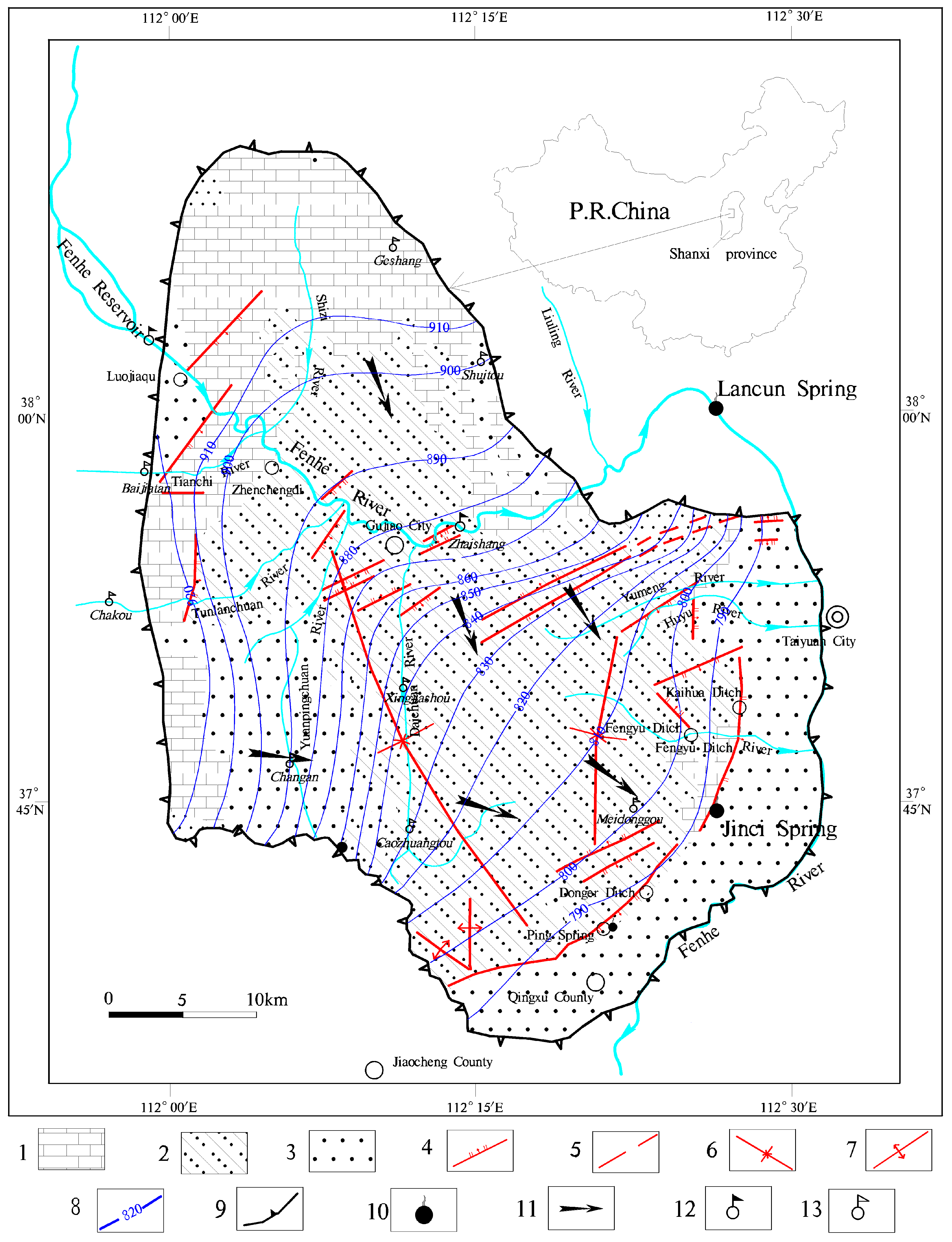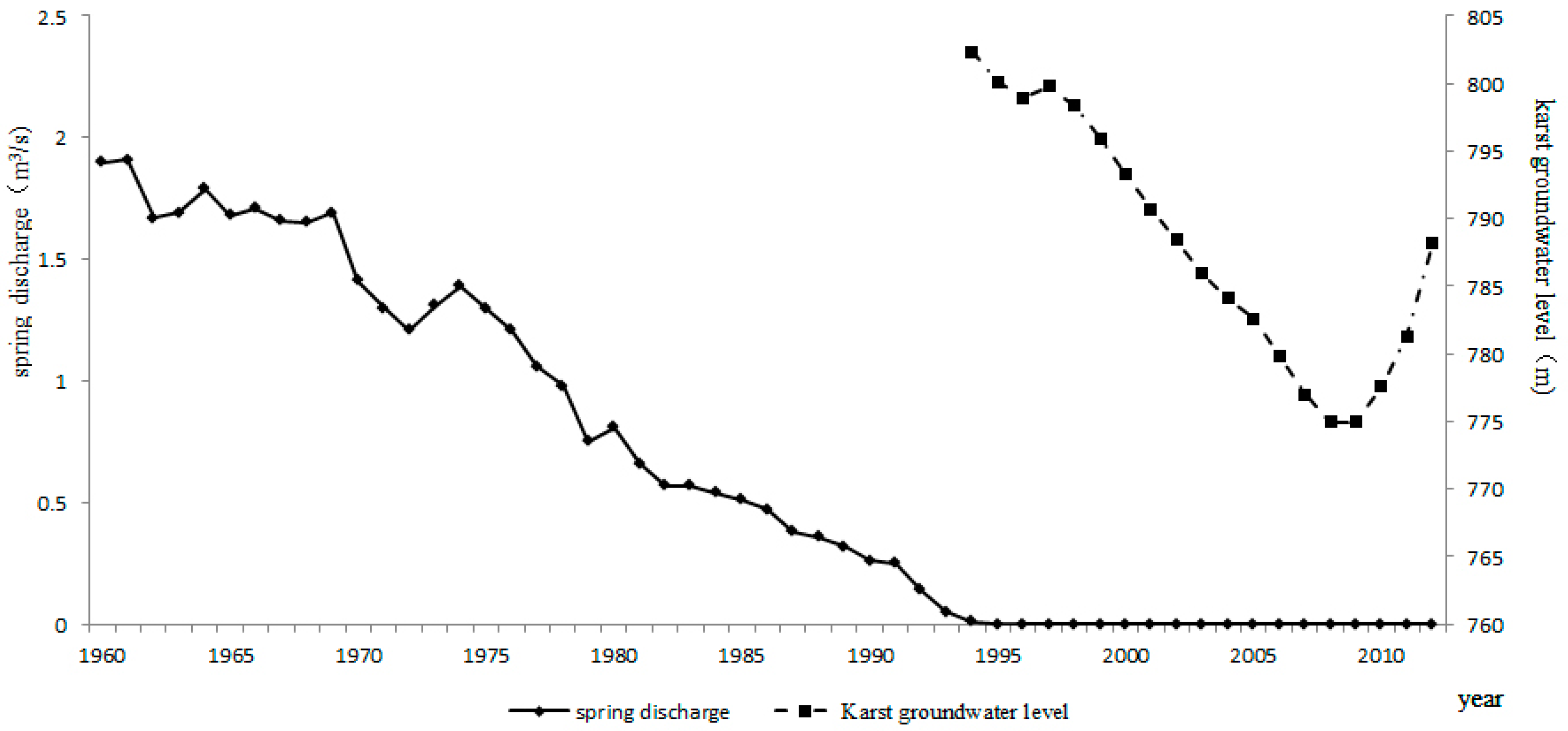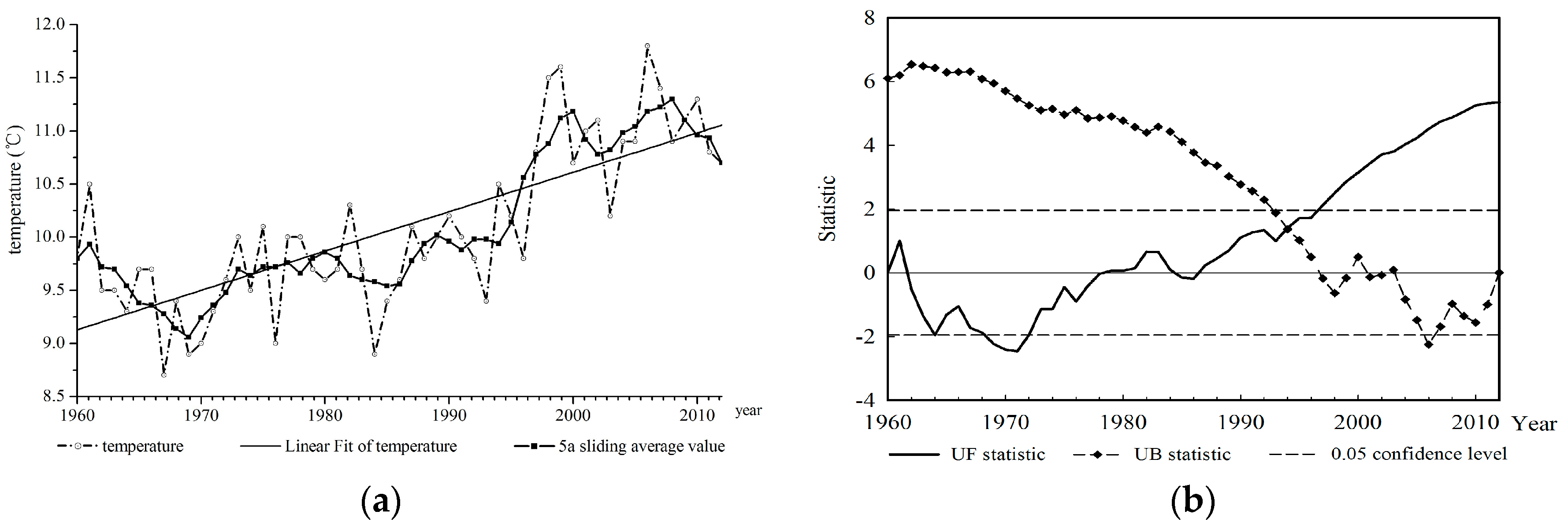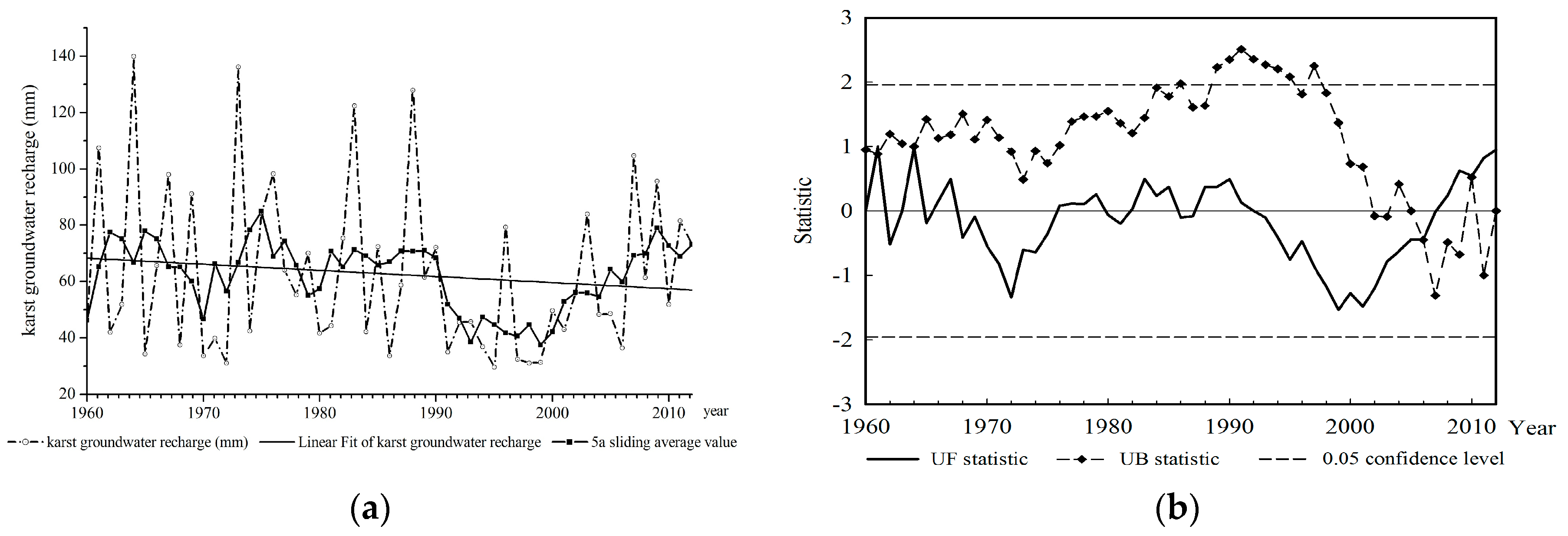Climate Change and Its Influence on the Karst Groundwater Recharge in the Jinci Spring Region, Northern China
Abstract
:1. Introduction
2. Research Area Overview
3. Research Method
3.1. Time-Series Test
3.1.1. Trend Test
3.1.2. Abrupt Change Test
3.2. Groundwater Recharge Amount Calculation
4. Results and Discussion
4.1. Climate Change Characteristic Analysis
4.1.1. Precipitation Variation
4.1.2. Temperature Variation
4.1.3. Evaporation Variation
4.2. Analysis of the Influence of Climate Change on Karst Groundwater Recharge in the Spring Region
5. Conclusions
- (1)
- By comparing the relationship between the change in precipitation and the discharge of the spring, the change in precipitation has a small contribution to the change in karst water level in the Jinci Spring region. The reason why the spring dried up is mainly attributed to groundwater over-abstraction.
- (2)
- A total of 53 years of statistics reveal that the annual precipitation of the Jinci Spring region generally follows an initial decreasing and then subsequent increasing trend, and the most obvious declining trend occurred in 1990s, which was 111 mm less than that of the 1960s. Likewise, the variation trend of land evaporation is similar to that of precipitation; however, the annual average temperature has maintained an increasing trend.
- (3)
- The variation process of the karst groundwater recharge in the Jinci Spring region is generally consistent with that of the precipitation. As compared to the climate of the 1960s, all the climate changes at the other time periods resulted in a reduction in the recharge amount. The climatic change had the strongest influence in the 1990s, which caused the karst groundwater recharge amount in the spring region to be reduced by 26.75 mm, about 39.68% lower than that of the 1960s. The reduction of precipitation is one of main reasons underlying the cutoff of the Jinci Spring.
- (4)
- The results of the Mann-Kendall abrupt change test revealed that the karst groundwater recharge amount in the Fenhe Reservoir-Zhaishang zone of the Jinci Spring region generally exhibits a declining tendency. The karst groundwater recharge amount exhibited a rising trend before 1967. After that, a declining trend took place; however, a rising trend has been occurring since 2007. The mutations existed in 1964 and 2007.
Acknowledgements
Author Contributions
Conflicts of Interest
Appendix A
| Year | Spring Discharge (m3/s) | Karst Groundwater Level (m) |
|---|---|---|
| 1960 | 1.9 | |
| 1961 | 1.91 | |
| 1962 | 1.67 | |
| 1963 | 1.69 | |
| 1964 | 1.79 | |
| 1965 | 1.68 | |
| 1966 | 1.71 | |
| 1967 | 1.66 | |
| 1968 | 1.65 | |
| 1969 | 1.69 | |
| 1970 | 1.41 | |
| 1971 | 1.3 | |
| 1972 | 1.21 | |
| 1973 | 1.31 | |
| 1974 | 1.39 | |
| 1975 | 1.3 | |
| 1976 | 1.21 | |
| 1977 | 1.06 | |
| 1978 | 0.98 | |
| 1979 | 0.75 | |
| 1980 | 0.81 | |
| 1981 | 0.66 | |
| 1982 | 0.57 | |
| 1983 | 0.57 | |
| 1984 | 0.54 | |
| 1985 | 0.51 | |
| 1986 | 0.47 | |
| 1987 | 0.38 | |
| 1988 | 0.36 | |
| 1989 | 0.32 | |
| 1990 | 0.26 | |
| 1991 | 0.25 | |
| 1992 | 0.14 | |
| 1993 | 0.05 | |
| 1994 | 0.01 | 802.32 |
| 1995 | 0 | 800.11 |
| 1996 | 0 | 798.97 |
| 1997 | 0 | 799.79 |
| 1998 | 0 | 798.37 |
| 1999 | 0 | 795.94 |
| 2000 | 0 | 793.3 |
| 2001 | 0 | 790.69 |
| 2002 | 0 | 788.42 |
| 2003 | 0 | 785.96 |
| 2004 | 0 | 784.07 |
| 2005 | 0 | 782.59 |
| 2006 | 0 | 779.86 |
| 2007 | 0 | 777 |
| 2008 | 0 | 774.94 |
| 2009 | 0 | 774.94 |
| 2010 | 0 | 777.54 |
| 2011 | 0 | 781.26 |
| 2012 | 0 | 788.21 |
| Year | The Precipitation in the Jinci Spring Area (mm) | Average Temperature (°C) | The Observed Runoff Amount in the Fenhe Reservoir Hydrologic Station (m3/s) | The Observed Runoff Amount in the Zhaishang Hydrologic Station (m3/s) |
|---|---|---|---|---|
| 1960 | 433.59 | 9.8 | 6.81 | 8.09 |
| 1961 | 558.89 | 10.5 | 6.98 | 8.2 |
| 1962 | 444.83 | 9.5 | 12.3 | 14.2 |
| 1963 | 506.34 | 9.5 | 10.6 | 13.7 |
| 1964 | 676.63 | 9.3 | 11.0 | 15.5 |
| 1965 | 260.63 | 9.7 | 19.9 | 19.3 |
| 1966 | 588.16 | 9.7 | 5.07 | 9.89 |
| 1967 | 642.10 | 8.7 | 27.2 | 33.1 |
| 1968 | 381.16 | 9.4 | 18.2 | 20.4 |
| 1969 | 584.83 | 8.9 | 14.3 | 18.3 |
| 1970 | 484.44 | 9 | 14.9 | 18.6 |
| 1971 | 453.94 | 9.3 | 8.54 | 10.9 |
| 1972 | 217.87 | 9.6 | 8.06 | 7.71 |
| 1973 | 641.07 | 10 | 5.55 | 8.38 |
| 1974 | 315.23 | 9.5 | 14.8 | 14 |
| 1975 | 477.61 | 10.1 | 5.34 | 5.68 |
| 1976 | 512.10 | 9 | 5.43 | 6.68 |
| 1977 | 555.91 | 10 | 9.95 | 13.6 |
| 1978 | 416.21 | 10 | 13.9 | 14.2 |
| 1979 | 486.16 | 9.7 | 13.6 | 15.1 |
| 1980 | 355.13 | 9.6 | 13.5 | 13.4 |
| 1981 | 358.19 | 9.7 | 6.97 | 6.78 |
| 1982 | 489.41 | 10.3 | 7.72 | 8.7 |
| 1983 | 495.87 | 9.7 | 8.65 | 7.79 |
| 1984 | 321.51 | 8.9 | 9.22 | 8.7 |
| 1985 | 492.36 | 9.4 | 4.89 | 6.62 |
| 1986 | 282.86 | 9.6 | 8.49 | 8.67 |
| 1987 | 413.17 | 10.1 | 3.78 | 3.84 |
| 1988 | 619.87 | 9.8 | 8.52 | 11.2 |
| 1989 | 412.33 | 10 | 9.54 | 9.48 |
| 1990 | 439.46 | 10.2 | 9.34 | 9.29 |
| 1991 | 376.33 | 10 | 8.43 | 8.95 |
| 1992 | 397.77 | 9.8 | 5.24 | 5.75 |
| 1993 | 381.11 | 9.4 | 7.73 | 8.02 |
| 1994 | 395.11 | 10.5 | 5.56 | 6.19 |
| 1995 | 485.76 | 10.2 | 12.5 | 15.7 |
| 1996 | 569.90 | 9.8 | 21.7 | 24.7 |
| 1997 | 243.46 | 10.8 | 9.21 | 8.87 |
| 1998 | 385.76 | 11.5 | 8.30 | 8.8 |
| 1999 | 292.43 | 11.6 | 7.35 | 7.41 |
| 2000 | 462.59 | 10.7 | 3.89 | 4.05 |
| 2001 | 379.63 | 11 | 3.8 | 4.09 |
| 2002 | 509.67 | 11.1 | 3.04 | 3.7 |
| 2003 | 551.73 | 10.2 | 5.46 | 5.77 |
| 2004 | 416.67 | 10.9 | 5.84 | 4.98 |
| 2005 | 425.05 | 10.9 | 4.02 | 3.32 |
| 2006 | 425.79 | 11.8 | 3.12 | 2.99 |
| 2007 | 630.25 | 11.4 | 2.36 | 2.67 |
| 2008 | 474.58 | 10.9 | 7.16 | 6.63 |
| 2009 | 621.03 | 11.1 | 6.13 | 7.07 |
| 2010 | 436.44 | 11.3 | 6.51 | 7.14 |
| 2011 | 587.04 | 10.8 | 7.37 | 8.52 |
| 2012 | 499.89 | 10.7 | 6.64 | 7.48 |
References
- Tazioli, A.; Mattioli, A.; Nanni, T.; Vivalda, P.M. Natural Hazard Analysis in the Aspio Equipped Basin. In Engineering Geology for Society and Territory–Volume 3: River Basins, Reservoir Sedimentation and Water Resources; Springer International Publishing: Cham, Switzerland, 2015; pp. 431–435. [Google Scholar]
- Goderniaux, P.; Brouyere, S.; Fowler, H.J.; Blenkinsop, S.; Therrien, R.; Orban, P.; Dassargues, A. Large scale surface-subsurface hydrological model to assess climate change impacts on groundwater reserves. J. Hydrol. 2009, 373, 122–138. [Google Scholar] [CrossRef]
- Kundzewicz, Z.W.; Doll, P. Will groundwater ease freshwater stress under climate change. Hydrol. Sci. J. 2009, 54, 665–675. [Google Scholar] [CrossRef]
- Liu, C.Z.; Xie, Z.H. Recent advances in research on sensitivity of groundwater to climatic changes. J. China Hydrol. 2007, 27, 1–6. (In Chinese) [Google Scholar]
- Holman, I.P.; Tascone, D.; Hess, T.M. A comparison of stochastic and deterministic downscaling methods for modelling potential groundwater recharge under climate change in East Anglia, UK: Implications for groundwater resource management. Hydrogeol. J. 2009, 17, 1629–1641. [Google Scholar] [CrossRef]
- Doveri, M.; Mussi, M. Water Isotopes as Environmental Tracers for Conceptual Understanding of Groundwater Flow: An Application for Fractured Aquifer Systems in the “Scansano-Magliano in Toscana” Area (Southern Tuscany, Italy). Water 2014, 6, 2255–2277. [Google Scholar] [CrossRef]
- Cervi, F.; Corsini, A.; Doveri, M.; Mussi, M.; Ronchetti, F.; Tazioli, A. Characterizing the Recharge of Fractured Aquifers: A Case Study in a Flysch Rock Mass of theNorthern Apennines (Italy). In Engineering Geology for Society and Territory—Volume 3: River Basins, Reservoir Sedimentation and Water Resources; Springer International Publishing: Cham, Switzerland, 2015; pp. 563–567. [Google Scholar]
- Jackson, C.R.; Meister, R.; Prudhomme, C. Modelling the effects of climate change and its uncertainty on UK Chalk groundwater resources from an ensemble of global climate model projections. J. Hydrol. 2011, 399, 12–28. [Google Scholar] [CrossRef]
- Wang, W.T.; Liang, Y.P.; Wang, Z.H.; Zhao, C.H. Characteristics of climate change in northern China and its effect on groundwater in karst areas. Hydrolgeol. Eng. Geol. 2012, 39, 6–10. (In Chinese) [Google Scholar]
- Huang, H.L. The relationship between the cutoff of Jinci Spring and the conservation of groundwater resource. Coal. Geol. China 2003, 15, 26–28. (In Chinese) [Google Scholar]
- Long, Y.Q.; Li, W.; Li, Y.G. Tank model of Jinci karst groundwater system under the on the condition of simultaneous draining in minging. Carsologica Sin. 2011, 30, 27–33. (In Chinese) [Google Scholar]
- Sun, C.Z.; Wang, J.S.; Lin, X.Y. Research on the Shanxi Jinci Spring’s recovery after the use of water from the yellow river as municipal water supply. Carsol. Sin. 2001, 20, 11–16. (In Chinese) [Google Scholar]
- Guo, Q.H.; Wang, Y.X.; Ma, T. The flow variation processes of large karstic spring in Shanxi in the recent 50 years and its guiding significance on global climatic change. Sci. China. Ser. D 2005, 35, 167–175. (In Chinese) [Google Scholar]
- Green, T.R.; Taniguchi, M.; Kooi, H.; Gurdak, J.J.; Allen, D.M.; Hiscock, K.M.; Treidel, H.; Aureli, A. Beneath the surface of global change: Impacts of climate change on groundwater. J. Hydrol. 2011, 405, 532–560. [Google Scholar] [CrossRef]
- Bloomfield, J.P.; Williams, R.J.; Gooddy, D.C.; Cape, J.N.; Guha, P. Impacts of climate change on the fate and behaviour of pesticides in surface and groundwater—A UK perspective. Sci. Total Environ. 2006, 369, 163–177. [Google Scholar] [CrossRef] [PubMed]
- Ali, R.; McFarlane, D.; Varma, S.; Dawes, W.; Emelyanova, I.; Hodgson, G.; Charles, S. Potential climate change impacts on groundwater resources of south–western Australia. J. Hydrol. 2012, 475, 456–472. [Google Scholar] [CrossRef]
- Barron, O.; Froend, R.; Hodgson, G.; Ali, R.; Dawes, W.; Davies, P.; McFarlane, D. Projected risks to groundwater–dependent terrestrial vegetation caused by changing climate and groundwater abstraction in the Central Perth Basin, Western Australia. Hydrol. Process. 2014, 28, 5513–5529. [Google Scholar] [CrossRef]
- Waibel, M.S.; Gannett, M.W.; Chang, H.; Hulbe, C.L. Spatial variability of the response to climate change in regional groundwater systems—Examples from simulations in the Deschutes Basin, Oregon. J. Hydrol. 2013, 486, 187–201. [Google Scholar] [CrossRef]
- Yadav, R.; Tripathi, S.K.; Pranuthi, G.; Dubey, S.K. Trend analysis by Mann–Kendall test for precipitation and temperature for thirteen districts of Uttarakhand. J. Agrometeorol. 2014, 16, 164–171. [Google Scholar]
- Hamed, K.H. Trend detection in hydrologic data: The Mann–Kendall trend test under the scaling hypothesis. J. Hydrol. 2008, 349, 350–363. [Google Scholar] [CrossRef]
- Lacombe, G.; McCartney, M.; Forkuor, G. Drying climate in Ghana over the period 1960–2005: Evidence from the resampling–based Mann–Kendall test at local and regional levels. Hydrol. Sci. J. 2012, 57, 1594–1609. [Google Scholar] [CrossRef]
- Keilholz, P.; Disse, M.; Halik, U. Effects of Land Use and Climate Change on Groundwater and Ecosystems at the Middle Reaches of the Tarim River Using the MIKE SHE Integrated Hydrological Model. Water 2015, 7, 3040–3056. [Google Scholar] [CrossRef]
- Liu, Y.L.; Zhai, X.L.; Zheng, A.Q. Analysis of precipitation variation trend in Guanzhong Basin based on the Mann–Kendall. Yellow River 2012, 34, 28–30. (In Chinese) [Google Scholar]
- Hamed, K.H. Exact Distribution of the Mann–Kendall Trend Statistic for Persistent Data. J. Hydrol. 2009, 365, 86–94. [Google Scholar] [CrossRef]
- Gain, A.K.; Giupponi, C.; Renaud, F.G. Climate Change Adaptation and Vulnerability Assessment of Water Resources Systems in Developing Countries: A Generalized Framework and a Feasibility Study in Bangladesh. Water 2012, 4, 345–366. [Google Scholar] [CrossRef]
- Fathelrahman, E.; Davies, A.; Davies, S.; Pritchett, J. Assessing Climate Change Impacts on Water Resources and Colorado Agriculture Using an Equilibrium Displacement Mathematical Programming Model. Water 2014, 6, 1745–1770. [Google Scholar] [CrossRef]
- Baruffi, F.; Cisotto, A.; Cimolino, A.; Ferri, M.; Monego, M.; Norbiato, D.; Cappelletto, M.; Bisaglia, M.; Pretner, A.; Galli, A. Climate change impact assessment on Veneto and Friuli plain groundwater. Part I: An integrated modeling approach for hazard scenario construction. Sci. Total. Environ. 2012, 440, 154–166. [Google Scholar] [CrossRef] [PubMed]
- Samper, J.; Li, Y.M.; Pisani, B. An evaluation of climate change impacts on groundwater flow in the Plana de La Galera and Tortosa alluvial aquifers (Spain). Environ. Earth. Sci. 2015, 73, 2595–2608. [Google Scholar] [CrossRef]
- Tang, G.; Ding, Y.; Wang, S.; Ren, G.; Liu, H.; Zhang, L. Comparative analysis of the time series of surface air temperature over China for the last 100 years. Adv. Clim. Chang. Res. 2009, 5, 71–78. (In Chinese) [Google Scholar]
- Pasini, S.; Torresan, S.; Rizzi, J.; Zabeo, A.; Critto, A.; Marcomini, A. Climate change impact assessment in Veneto and Friuli Plain groundwater. Part II: A spatially resolved regional risk assessment. Sci. Total. Environ. 2012, 440, 219–235. [Google Scholar] [CrossRef] [PubMed]
- Turc, L. The water balance of soils—Relation between precipitation evaporation and flow. Ann. Agron. 1954, 5, 491–569. [Google Scholar]
- Ribeiro, L.; Kretschmer, N.; Nascimento, J.; Buxo, A.; Rotting, T.; Soto, G.; Senoret, M.; Oyarzun, J.; Maturana, H.; Oyarzun, R. Evaluating piezometric trends using the Mann–Kendall test on the alluvial aquifers of the Elqui River basin, Chile. Hydrol. Sci. J. 2015, 60, 1840–1852. [Google Scholar] [CrossRef]
- Stefanova, A.; Hesse, C.; Krysanova, V. Combined Impacts of Medium Term Socio–Economic Changes and Climate Change on Water Resources in a Managed Mediterranean Catchment. Water 2015, 7, 1538–1567. [Google Scholar] [CrossRef]
- Ligaray, M.; Kim, H.; Sthiannopkao, S.; Lee, S.; Cho, K.H.; Kim, J.H. Assessment on Hydrologic Response by Climate Change in the Chao Phraya River Basin, Thailand. Water 2015, 7, 6892–6909. [Google Scholar] [CrossRef]






| Time | 1960s | 1970s | 1980s | 1990s | 2000–2012 | Variation Degree between the 1960s and after 2000(%) |
|---|---|---|---|---|---|---|
| Average precipitation/mm | 507.7 | 456.1 | 424.1 | 396.7 | 493.9 | −2.73 |
| Average temperature/°C | 9.5 | 9.62 | 9.71 | 10.38 | 10.98 | 15.63 |
| Average evaporation/mm | 383.90 | 363.13 | 350.3 | 339.47 | 400.33 | 4.28 |
| Average karst groundwater recharge/mm | 67.40 | 63.47 | 65.98 | 40.66 | 59.53 | −11.68 |
| Element | Multi-Year Average Value/mm | M–K Trend Test | Mutation Point (Year) | ||
|---|---|---|---|---|---|
| Z | β | Trend | |||
| Precipitation | 457.85 | −0.22 | −0.41 | Declining | 1967, 2009 |
| Temperature | 10.09 | 6.10 | 0.04 | Rising | 1994 |
| Land evaporation | 369.29 | 0.41 | 0.15 | Rising | 1964, 2007 |
| Karst groundwater recharge | 59.37 | −1.04 | −0.25 | Declining | 1964, 2007 |
© 2017 by the authors. Licensee MDPI, Basel, Switzerland. This article is an open access article distributed under the terms and conditions of the Creative Commons Attribution (CC BY) license (http://creativecommons.org/licenses/by/4.0/).
Share and Cite
Jia, Z.; Zang, H.; Zheng, X.; Xu, Y. Climate Change and Its Influence on the Karst Groundwater Recharge in the Jinci Spring Region, Northern China. Water 2017, 9, 267. https://doi.org/10.3390/w9040267
Jia Z, Zang H, Zheng X, Xu Y. Climate Change and Its Influence on the Karst Groundwater Recharge in the Jinci Spring Region, Northern China. Water. 2017; 9(4):267. https://doi.org/10.3390/w9040267
Chicago/Turabian StyleJia, Zhenxing, Hongfei Zang, Xiuqing Zheng, and Yongxin Xu. 2017. "Climate Change and Its Influence on the Karst Groundwater Recharge in the Jinci Spring Region, Northern China" Water 9, no. 4: 267. https://doi.org/10.3390/w9040267





